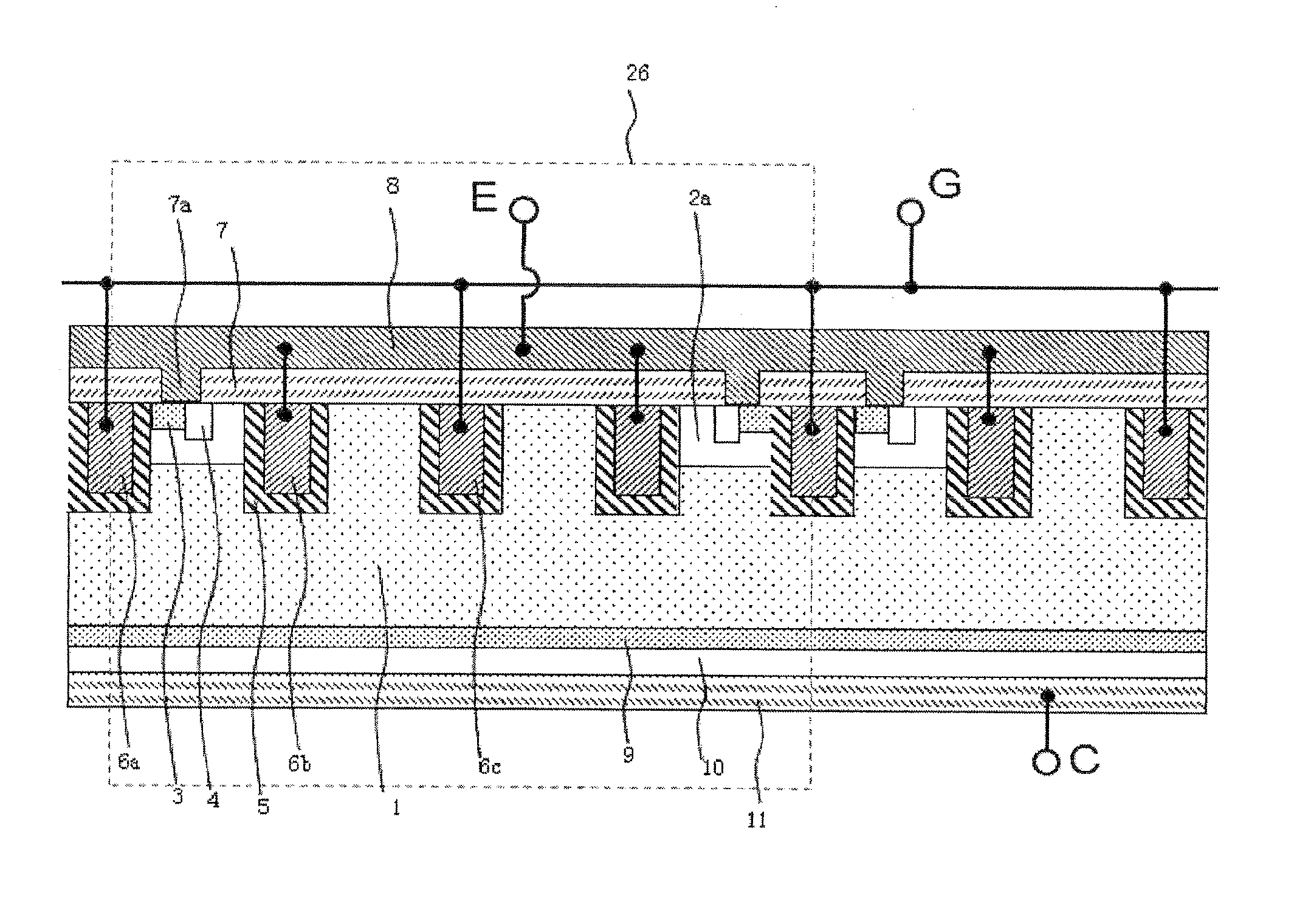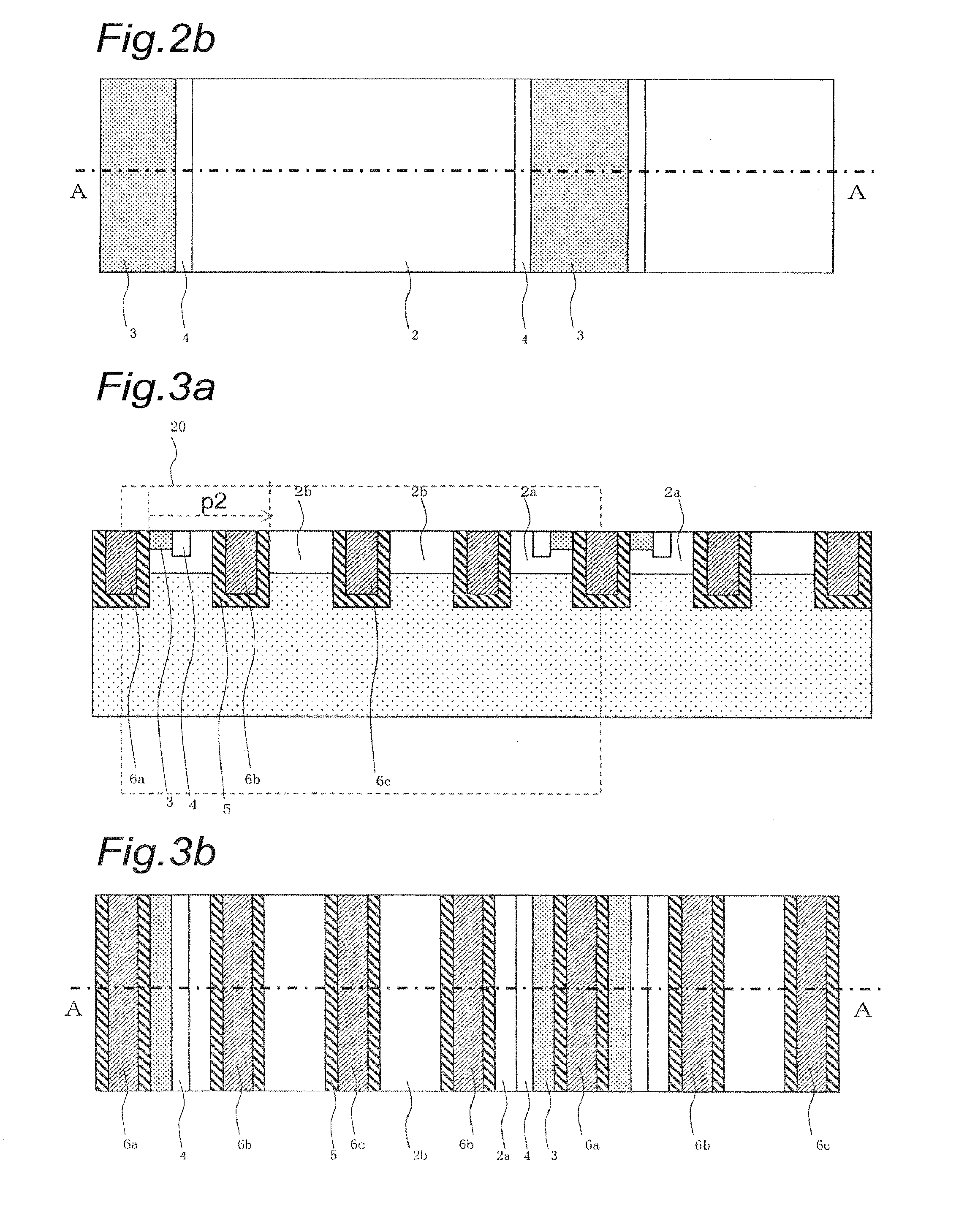Power semiconductor device
a technology of semiconductor devices and semiconductors, applied in the direction of semiconductor devices, basic electric elements, electrical equipment, etc., can solve the problem of inability to reduce turn-on losses, and achieve the effect of reducing turn-on losses, increasing the time rate of change in collector voltage, and enhancing the modulation effect of conductivity to the contribution of collector curren
- Summary
- Abstract
- Description
- Claims
- Application Information
AI Technical Summary
Benefits of technology
Problems solved by technology
Method used
Image
Examples
first embodiment
[0037]FIG. 1 is a cross-sectional view of a vertical trench IGBT according to a first embodiment of the present invention generally denoted by 20 and a portion surrounded by a dashed line is a unit IGBT. The trench IGBT 20 includes an n-type (first-conductive-type) base region 1 (a first-conductive-type first base region) having a first principal surface (front surface) and a second principal surface (back surface) opposite to the first principal surface. The front surface of the n-type base region 1 on the first principal surface side includes a selectively formed p-type (second-conductive-type) base region 2.
[0038]The trench IGBT 20 includes n-type emitter regions 3 (first-conductive-type emitter regions) selectively formed shallower than the p-type base region 2 in a stripe shape in the front surface of the p-type base region 2 on the first principal surface side and p-type contact regions 4 (second-conductive-type first contact regions) formed shallower than the p-type base regi...
second embodiment
[0074]FIG. 12 is a cross-sectional view of a trench IGBT according to a second embodiment of the present invention generally denoted by 23 and a portion surrounded by a dashed line is a unit IGBT. In FIG. 12, the same reference numerals as FIG. 1 denote the same or corresponding portions.
[0075]The trench IGBT 23 according to the second embodiment of the present invention has a structure having the p-type contact region 4 disposed in the p-type base region 2b interposed between the two active dummy trench gates 6c in the trench IGBT 22a (see FIG. 7) according to the modification example of the first embodiment. An opening region 7c is formed in the interlayer insulating film 7 such that the p-type contact region 4 is partially exposed, and the p-type contact region 4 is connected to the emitter electrode 8.
[0076]Since only the p-type base region 2b interposed between the two active dummy trench gates 6c is provided with the p-type contact region 4 as described above, although a porti...
third embodiment
[0078]FIG. 13 is a cross-sectional view of a trench IGBT according to a third embodiment of the present invention generally denoted by 24 and a portion surrounded by a dashed line is a unit IGBT. In FIG. 13, the same reference numerals as FIG. 1 denote the same or corresponding portions.
[0079]The trench IGBT 24 according to the third embodiment of the present invention has a structure having a distance between the isolated dummy trench gate 6b and the active dummy trench gate 6c made narrower as compared to a distance between the active trench gate 6a and the isolated dummy trench gate 6b in the trench IGBT 20 (see FIG. 1) according to the first embodiment. Therefore, since it is not necessary to dispose a contact region in the p-type base region between the isolated dummy trench 6b and the active dummy trench gate 6c, the distance between the isolated dummy trench gate 6b and the active dummy trench gate 6c can be reduced to a minimum design rule of a semiconductor process.
[0080]In...
PUM
 Login to View More
Login to View More Abstract
Description
Claims
Application Information
 Login to View More
Login to View More - R&D
- Intellectual Property
- Life Sciences
- Materials
- Tech Scout
- Unparalleled Data Quality
- Higher Quality Content
- 60% Fewer Hallucinations
Browse by: Latest US Patents, China's latest patents, Technical Efficacy Thesaurus, Application Domain, Technology Topic, Popular Technical Reports.
© 2025 PatSnap. All rights reserved.Legal|Privacy policy|Modern Slavery Act Transparency Statement|Sitemap|About US| Contact US: help@patsnap.com



